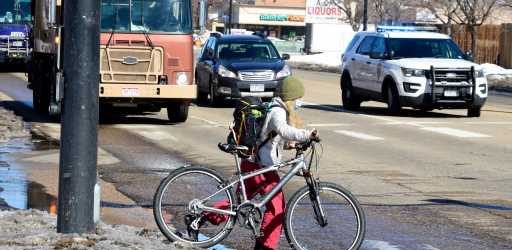In 2019, Tila Duhaime recalls taking a city-led bike ride along 28th Street from Valmont Road to Iris Avenue as part of a capital improvements tour ahead of a project scheduled along that stretch of road.
Duhaime, chair of the city’s Transportation Advisory Board, is an avid cyclist, but she said the experience was “terrifying and uncomfortable and unpleasant.” At the end of the ride, Duhaime said it was clear to her that improvements were necessary.
Boulder in about a year is scheduled to begin construction on the north segment of the 28th Street project. The full project, which was split into three segments and cost about $30 million in full, is more than two decades in the making. By the city’s estimation, the final segment will take anywhere from nine to 12 months to complete once construction begins in early to mid-2022.
According to Gerrit Slatter, principal transportation projects engineer, the last segment, which extends from Canyon Boulevard to Iris Avenue, currently includes building a multiuse path, adding shared bike-bus lanes in each direction as well as designing a bus bay that’s part of a regional partnership to accommodate bus service along Colo. 119.
However, Community Cycles, a Boulder-based cycling advocacy organization, expressed concerns about the final segment of the project, particularly the shared bike-bus lanes, which the organization views as dangerous and unlikely to be used by cyclists.
Considering projects take time to design, fund and construct, Community Cycles noted something it views as a larger concern: the potential for transportation projects approved years ago to move forward despite no longer fitting the city’s current transportation, safety and climate goals.
“Unfortunately, we were deeply disappointed to see a design that, at its heart, is based on concepts and conventions of transportation engineering that are more than 20 years old, and that fail to incorporate many recent innovations in human-centered urban transportation design,” the organization stated in a letter.
Slatter acknowledged it can be a challenge but that the city always encourages community feedback and considers and provides design changes to the extent it can. Sometimes the framework of a project is such that the department has limited ability to accommodate all requests, he said. This could be due to budget constraints, an inability to acquire the right-of-way or land necessary for certain infrastructure or scheduling conflicts.
“We realize that thoughts about how to really effectively provide a multimodal corridor (have) changed. We’d like to respond to that and provide a facility that’s truly multimodal and responds to the needs of ones that we hope will use it,” he said.
Additionally, Slatter said Boulder has “long been a leader in active transportation and non-motorized transportation systems where residents can have choices about how they move.” Because of this, he said it’s not often the city finds itself in a place where serious changes must be made due to incompatibility with Boulder’s current goals.
Still, Duhaime said when the city has to redo plans, it can create an uncomfortable situation for all involved — whether that’s city staff who are doing their best or cyclists who no longer feel safe riding in a particular area.
“All of those people are in very uncomfortable positions, and it’s hard to know who has to flinch first to move in the right direction,” Duhaime said.
She said she recognizes the challenges the process can create for city staff and she was complimentary of the city’s timing on this particular project. Boulder presented to the Community Cycles Advocacy Committee in the design finalization stage. Seeking feedback early allows time for adjustments, she said.
“If we all have time to say what we need, go back to our corners, take a breather, reassess (and) really try to understand those different perspectives, I think you’ll end up with a better outcome,” Duhaime said.
Community Cycles Executive Director Sue Prant expressed similar sentiments.
“I think we’re both working toward the same goal of safer streets, but I think we also have to understand that getting to that goal requires some sacrifices and maybe some new thinking,” Prant said. “The illusion that you’re going to be able to have it all … that’s probably not true.
“Every roadway is a decision of space allocation and priorities. What you choose to prioritize by the space you give them says a lot,” she added.
Duhaime agreed that it will take innovation and a new source of funding to make progress in that regard, considering the transportation department historically has been underfunded, a situation made worse by the coronavirus pandemic’s impact on city tax revenue, according to the city’s Transportation Report on Progress.
In response to some of the feedback, Slatter said the city is presenting some potential changes at the April Transportation Advisory Board meeting. One example of a change that is being explored and reviewed is not marking the bus lane as a shared facility to be used by both bikes and buses, he said.
A primary goal of the Low Stress Bike Network is to make cycling a travel choice that’s appealing to all ages and abilities, Slatter noted.
“So the bus lane could still be used by cyclists, but it wouldn’t be signed and marked as a ‘preferred’ travel location,” he wrote in an email. “Instead the newly constructed multi-use path (located behind the street curb) would be the preferred ‘low-stress’ location for cyclists.”
Source: Read Full Article



